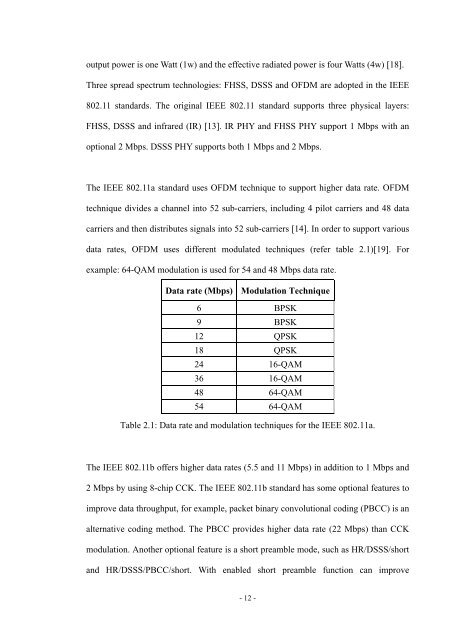An Investigation of the Impact of Signal Strength on Wi-Fi Link ...
An Investigation of the Impact of Signal Strength on Wi-Fi Link ...
An Investigation of the Impact of Signal Strength on Wi-Fi Link ...
You also want an ePaper? Increase the reach of your titles
YUMPU automatically turns print PDFs into web optimized ePapers that Google loves.
output power is <strong>on</strong>e Watt (1w) and <str<strong>on</strong>g>the</str<strong>on</strong>g> effective radiated power is four Watts (4w) [18].<br />
Three spread spectrum technologies: FHSS, DSSS and OFDM are adopted in <str<strong>on</strong>g>the</str<strong>on</strong>g> IEEE<br />
802.11 standards. The original IEEE 802.11 standard supports three physical layers:<br />
FHSS, DSSS and infrared (IR) [13]. IR PHY and FHSS PHY support 1 Mbps with an<br />
opti<strong>on</strong>al 2 Mbps. DSSS PHY supports both 1 Mbps and 2 Mbps.<br />
The IEEE 802.11a standard uses OFDM technique to support higher data rate. OFDM<br />
technique divides a channel into 52 sub-carriers, including 4 pilot carriers and 48 data<br />
carriers and <str<strong>on</strong>g>the</str<strong>on</strong>g>n distributes signals into 52 sub-carriers [14]. In order to support various<br />
data rates, OFDM uses different modulated techniques (refer table 2.1)[19]. For<br />
example: 64-QAM modulati<strong>on</strong> is used for 54 and 48 Mbps data rate.<br />
Data rate (Mbps) Modulati<strong>on</strong> Technique<br />
6 BPSK<br />
9 BPSK<br />
12 QPSK<br />
18 QPSK<br />
24 16-QAM<br />
36 16-QAM<br />
48 64-QAM<br />
54 64-QAM<br />
Table 2.1: Data rate and modulati<strong>on</strong> techniques for <str<strong>on</strong>g>the</str<strong>on</strong>g> IEEE 802.11a.<br />
The IEEE 802.11b <str<strong>on</strong>g>of</str<strong>on</strong>g>fers higher data rates (5.5 and 11 Mbps) in additi<strong>on</strong> to 1 Mbps and<br />
2 Mbps by using 8-chip CCK. The IEEE 802.11b standard has some opti<strong>on</strong>al features to<br />
improve data throughput, for example, packet binary c<strong>on</strong>voluti<strong>on</strong>al coding (PBCC) is an<br />
alternative coding method. The PBCC provides higher data rate (22 Mbps) than CCK<br />
modulati<strong>on</strong>. <str<strong>on</strong>g>An</str<strong>on</strong>g>o<str<strong>on</strong>g>the</str<strong>on</strong>g>r opti<strong>on</strong>al feature is a short preamble mode, such as HR/DSSS/short<br />
and HR/DSSS/PBCC/short. <strong>Wi</strong>th enabled short preamble functi<strong>on</strong> can improve<br />
- 12 -
















